ISRO PLANS FOR NUCLEAR ENERGY USE IN SPACE
WEDNESDAY, MAY 19, 2021 BY INDIAN DEFENCE NEWS
On 28 January, 2021, the UR Rao Satellite Centre (URSC) of Indian Space Research Organisation (ISRO) invited proposals for the three phase development of a 100 Watt Radioisotope Thermoelectric Generator (RTG). As ISRO’s lead centre for design, development, fabrication, and testing of all Indian-made satellites, the centre envisions using RTG for power generation and thermal management of ISRO’s deep space missions. With plans of setting up a space station, and launching the first Indian human space flight mission, Gaganyaan; the first Indian solar observatory, Aditya L-1; the second Indian space telescope XPoSat; Mangalyaan-2 to Mars; Chandrayaan-3 as a reattempt to land on the Moon; and the Venus orbiter mission Shukrayaan; ISRO has embarked on a monumental journey of exploring remote and challenging environments. It has told the world that India does not want to be a nascent space player anymore.
Against this backdrop, the decision to invest in nuclear thermal propulsion (NTP) appears inevitable. RTGs are not new but the use of nuclear energy for launching rockets had been long given up, though small nuclear-powered rovers like the US’s Perseverance have been in use. RTGs were first used in space during the Cold War in 1961 for the US’s Transit-4A Mission. Since then, the erstwhile Soviet Union had launched over two dozen nuclear-powered space objects. However, budget constraints, complicated designs, progress in alternative sources of energy, and the possibility of escalation of the Cold War led to the curtailment of nuclear propulsion projects.
RTGs are not new but the use of nuclear energy for launching rockets had been long given up, though small nuclear-powered rovers like the US’s Perseverance have been in use
Now, as the importance of the space frontier and the desire to make new scientific discoveries increase, nuclear power sources have come into the spotlight once more. RTGs provide power by using thermocouples to convert thermal energy generated by the natural decay of radioactive isotopes into electrical energy. They are highly reliable and maintenance-free as the absence of moving parts in thermocouples reduces the chances of failure and wear out. Nuclear-propelled rockets are more fuel efficient and lighter than chemical rockets. Hence, they would travel further, are faster, and would shorten the trip time. At the India Energy Forum, the US Energy Secretary, Dan Brouillette, emphasised this when he claimed that the new fuel would allow a trip to and from Mars on ‘one tank of gas’. “What would take years, would take only months (now),” he said. This would also prove beneficial for human space travel. The astronauts’ exposure to harmful space radiations would be lessened, thereby, decreasing the mission’s overall risk. The Chief Engineer of NASA’s Space Technology Mission Directorate, Jeff Sheehy, notes “the longer you’re out there, the more time there is for stuff to go wrong”.
Nuclear or radioactive energy can be employed both as an alternative to and a complement of other sources of energy. This is seconded by former ISRO Chairman, AS Kiran Kumar, who calls RTG ‘futuristic’. RTGs are an unmatched alternative to solar power. Solar power is not an option for space objects meant to operate on the dark sides of planets where sunlight is obscured. Its intensity is inversely proportional to the square of the distance between the celestial body and the sun, hence, space objects sent to far off missions require an alternative source of energy. RTGs are independent of solar proximity and planetary alignment. This characteristic would help in minimising constraints like the ‘launch windows’ that the scientists have to operate within. More crucially, the current research is focused on developing radioisotope thermoelectric systems, which can provide thrust for interplanetary travel only, thereby, complementing the chemical rocket thrusters that launch the spacecraft beyond the low Earth orbit.
Even with the above-mentioned advantages over conventional sources of energy, nuclear space reactors stir controversy due to the inherent safety challenges. There is a risk of radioactive contamination, with a rocket explosion, disintegration or re-entrance into the atmosphere. However, if the highest standards of safety— keeping in mind both humans and the environment— are adopted, such risks can be minimised. A Seattle-based company, Ultra Safe Nuclear Technologies (USNC-Tech), claims to have designed an NTP engine that could protect the crew from being exposed to radioactive particles during the flight.
Nuclear space reactors stir controversy due to the inherent safety challenges. There is a risk of radioactive contamination, with a rocket explosion, disintegration or re-entrance into the atmosphere
After the re-entry of nuclear-powered KOSMOS 954 into the atmosphere in 1978, the United Nations Office for Outer Space Affairs (UNOOSA) adopted ‘Principles Relevant to the Use of Nuclear Power Sources in Outer Space’ which recognise that “for some missions in outer space, nuclear power sources are particularly suited or even essential owing to their compactness, long life, and other attributes”. It allows the use of nuclear reactors and radioisotope generators to operate on interplanetary missions and in sufficiently high orbits. ISRO, adhering to its commitment to the principle, has explicitly mentioned in the January document that “the unit should be able to [be] resilient to any pre-launch or post-launch explosion so as to not cause any nuclear contamination in the environment”. While chemical-powered rockets opened the door, nuclear energy would take humanity deeper into the space.
Source>>


